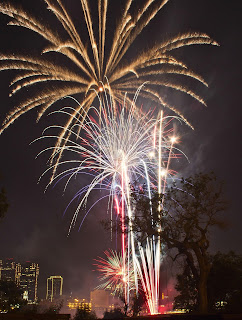These images show the progress that I have been making with my wet plate photography. Starting with some pretty bad images to some pretty remarkable images. I feel that I am progressing along nicely despite not having any hands on teaching or attending any workshops. I would love to attend some, I just don't have the time nor the money to do so right now.
Thursday, July 11, 2013
Wednesday, July 3, 2013
Photographing Fireworks
Here is a very brief tutorial on how to get the best images of fireworks.
- Use wide angle lens (or zoom out as far as you can)
- Most firework shows happen in a very confined space, so its best to shoot vertically to capture the entire path the firework takes from ground to sky.
- Set camera to RAW for best processing option
- Place camera on sturdy tripod
- Switch to Manual mode
- Focus to manual
- set focus to infinity or focus on the farthest object
- Set aperture to f/8-16
- Set shutterspeed to:
- 5-10 seconds for timelapse (make sure to not overexposure the foreground)
- BULB for total control (note this one requires cable release to limit camera shake)
- Find the best spot to get the images you want. The closer you are the more you will have to tilt your camera up. The farther away you are, you will have to zoom in which can compress the image.

One advanced tip is to shoot one image of the entire scene exposed properly (maybe even make multiple exposures to process in HDR) before the show starts. Leave the camera in the same spot for the remainder of the show and combine this shot with the others to create a very dramatic image.
Monday, July 1, 2013
"Super" Moon images
Last week the photography world was set atwitter by an astronomical event called the "Supemoon." This is when the moon reaches its closest point to the Earth and appears to be roughly 14% larger. This makes it, well, 14% easier to get a close up shot of the moon. Photographers from around the world ran out side (late at night or early in the morning) to photograph this moon. What some found, apparently, was that their camera did not capture the "supermoon" in all its humongous glory. Instead, the moon appeared small in the final image like the one below.
So, how to fix this problem. Well, its simple really. Take another picture using a telephoto lens. This, however, leads us to another problem. It looks like just any other moon photo. There are no foreground elements to compare the size to as seen in the following image.
Well, now what? Oh, screw it, we can just combine the two images together in photoshop and no one will be the wiser, like the image is now.
I have been seeing photos like this pop up all over the internet and people are amazed and in awe of not just the moon but the photographer and their ability to capture such an amazing image. If you are going to post photos like this, let everyone know that it is photoshopped. Otherwise, just post your true image of the supermoon. This is mine. Its not very impressive, but I still like it and I can say that it is not photoshopped.
So, how to fix this problem. Well, its simple really. Take another picture using a telephoto lens. This, however, leads us to another problem. It looks like just any other moon photo. There are no foreground elements to compare the size to as seen in the following image.
Well, now what? Oh, screw it, we can just combine the two images together in photoshop and no one will be the wiser, like the image is now.
I have been seeing photos like this pop up all over the internet and people are amazed and in awe of not just the moon but the photographer and their ability to capture such an amazing image. If you are going to post photos like this, let everyone know that it is photoshopped. Otherwise, just post your true image of the supermoon. This is mine. Its not very impressive, but I still like it and I can say that it is not photoshopped.
Subscribe to:
Comments (Atom)


















